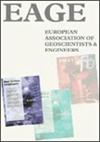Application of iterative elastic reverse time migration to shear horizontal ultrasonic echo data obtained at a concrete step specimen
IF 1.6
4区 地球科学
Q3 GEOCHEMISTRY & GEOPHYSICS
引用次数: 0
Abstract
The ultrasonic echo technique is broadly applied in non‐destructive testing (NDT) of concrete structures involving tasks such as measuring thickness, determining geometry and locating built‐in elements. To address the challenge of enhancing ultrasonic imaging for complex concrete constructions, we adapted a seismic imaging algorithm – reverse time migration (RTM) – for NDT in civil engineering. Unlike the traditionally applied synthetic aperture focusing technique (SAFT), RTM takes into account the full wavefield including primary and reflected arrivals as well as multiples. This capability enables RTM to effectively handle all wave phenomena, unlimited by changes in velocity and reflector inclinations. This paper concentrates on applying and evaluating a two‐dimensional elastic RTM algorithm that specifically addresses horizontally polarized shear (SH) waves only, as these are predominantly used in ultrasonic NDT of concrete structures. The elastic SH RTM algorithm was deployed for imaging real ultrasonic echo SH‐wave data obtained at a concrete specimen exhibiting a complex back wall geometry and containing four tendon ducts. As these features are frequently encountered in practical NDT scenarios, their precise imaging holds significant importance. By applying the elastic SH RTM algorithm, we successfully reproduced nearly all reflectors within the concrete specimen. In particular, we were capable of accurately reconstructing all vertically oriented reflectors as well as the circular cross sections of three tendon ducts, which was not achievable with traditional SAFT imaging. These findings demonstrate that elastic SH RTM holds the ability to considerably improve the imaging of complex concrete geometries, marking a crucial advancement for accurate, high‐quality ultrasonic NDT in civil engineering.将迭代弹性反向时间迁移应用于在混凝土台阶试件上获得的剪切水平超声回波数据
超声波回波技术广泛应用于混凝土结构的无损检测(NDT),涉及厚度测量、几何形状确定和内置元件定位等任务。为解决复杂混凝土结构的超声波成像增强难题,我们将地震成像算法--反向时间迁移(RTM)--应用于土木工程的无损检测。与传统应用的合成孔径聚焦技术(SAFT)不同,RTM 考虑到了整个波场,包括初至、反射到达和多重到达。这种能力使 RTM 能够有效处理所有波现象,不受速度和反射器倾斜度变化的限制。本文主要介绍一种二维弹性 RTM 算法的应用和评估,该算法只专门处理水平极化剪切(SH)波,因为这些波主要用于混凝土结构的超声无损检测。弹性 SH RTM 算法用于对混凝土试样获得的真实超声回波 SH 波数据进行成像,该试样具有复杂的后墙几何形状,并包含四条肌腱导管。由于这些特征在实际无损检测中经常出现,因此对它们进行精确成像具有重要意义。通过应用弹性 SH RTM 算法,我们成功地再现了混凝土试样内的几乎所有反射体。特别是,我们能够精确地重建所有垂直方向的反射体以及三个肌腱导管的圆形横截面,这是传统的 SAFT 成像无法实现的。这些研究结果表明,弹性 SH RTM 能够显著改善复杂混凝土几何形状的成像,标志着土木工程中精确、高质量超声无损检测的重要进步。
本文章由计算机程序翻译,如有差异,请以英文原文为准。
求助全文
约1分钟内获得全文
求助全文
来源期刊

Near Surface Geophysics
地学-地球化学与地球物理
CiteScore
3.60
自引率
12.50%
发文量
42
审稿时长
6-12 weeks
期刊介绍:
Near Surface Geophysics is an international journal for the publication of research and development in geophysics applied to near surface. It places emphasis on geological, hydrogeological, geotechnical, environmental, engineering, mining, archaeological, agricultural and other applications of geophysics as well as physical soil and rock properties. Geophysical and geoscientific case histories with innovative use of geophysical techniques are welcome, which may include improvements on instrumentation, measurements, data acquisition and processing, modelling, inversion, interpretation, project management and multidisciplinary use. The papers should also be understandable to those who use geophysical data but are not necessarily geophysicists.
 求助内容:
求助内容: 应助结果提醒方式:
应助结果提醒方式:


